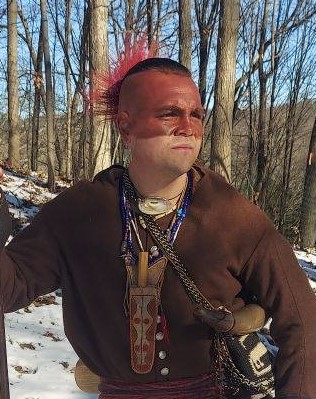
Drew Shuptar- Rayvis; Northern Cultural Ambassador of the Pocomoke Indian Nation and Algonkian Living Historian of the 17th and 18th century
Paint – Like body ornamentation in the form of piercings and tattoos, painting of the face and body was done for personal beautification and spiritual purpose. Paint can be divided into 1. Social Paint (paint worn day to day that was meant to beautify and enhance the looks of the wearer) 2. Combat Paint (paint worn specifically for combat that showed the aggressive and dark emotions of the warrior) and 3. Mourning Paint (paint that was used, mainly by women to show grief and sorrow from a death). For the first of these categories, red made from natural ocher ground or scrapped into a powder and mixed with bear grease was one of the most common social paints (as seen in our model) though on occasion was used as a combat color. Adrianne Van Der Donck records the use and wearing of red paint in his 1655 book where he says:
“Now the Indians are in the habit of decorating their faces, using paints in various conspicuous colors, the brighter and shinier the better they like it; The natives as repeatedly mentioned, paint their faces and bodies in various colors, the one stranger and odder than the other, according to their fancy. To that end they have and usually carry with them small leather bags, each containing a different dye, such as red, blue, green, brown, white, black, and yellow, etc. The most precious and sought after of these is the dye that glitters the most and shines as though it were fillings of some refined metal [ possibly describing graphite ore] (Indian New England 1524-1674, Ronald Dale Karr Pg’s 39-42)
Paint was also worn for combat, typically these colors were a combination of red and black either on the face or the whole body. In the Algonkian world painting was done to show and express physical emotion and to be used as metaphor. Red for many eastern woodland people symbolized life (since red is the color of blood which makes all mammals live, essentially sacred water) the rising sun/ east direction, but also vitality and health; black on the other hand showed the dark emotions, anger, the absence of light, sadness, death. Besides the metaphorical meanings these colors also break up the human shape incredibly well in a forested environment and were used for that reason as well. William Wood an English traveler and explorer wrote of warpaint in 1634 where he says
“It is their custom to paint their faces with diversity of colors, some being all black as jet, some red, some half red and half black, some black and white, others spotted with diverse kinds of colors, being all disguised to their enemies, to make them more terrible to their foes” (Indian New England 1524-1674, Ronald Dale Karr Pg’s 116-117, William Wood, 1634, 94-95)
Lastly. Paint was worn to physically show mourning, loss and sadness. William Wood describes the scene “The date of their life expired, and death’s arrestment seizing upon them, all hope of recovery being past, then to behold and hear their throbbing sobs and deep fetched sighs, their grief-wrung hands and tear-bedewed cheeks, their doleful cries, would draw tears from Adamantine eyes, that be but spectators of their mournful obsequies. The glut of their grief being past, they commit the corpses of their deceased friend to the ground, over whose grave is for a long time spent many a briny tear, deep groan, and Irish-like howlings, continuing annual mournings with a black stiff paint on their faces.” (Indian New England 1524-1674, Ronald Dale Karr, Pg’s 134-135, William Wood, 1634, 104-05)
Drew Shuptar- Rayvis ; Northern Cultural Ambassador of the Pocomoke Indian Nation and Algonkian Living Historian of the 17th and 18th century

